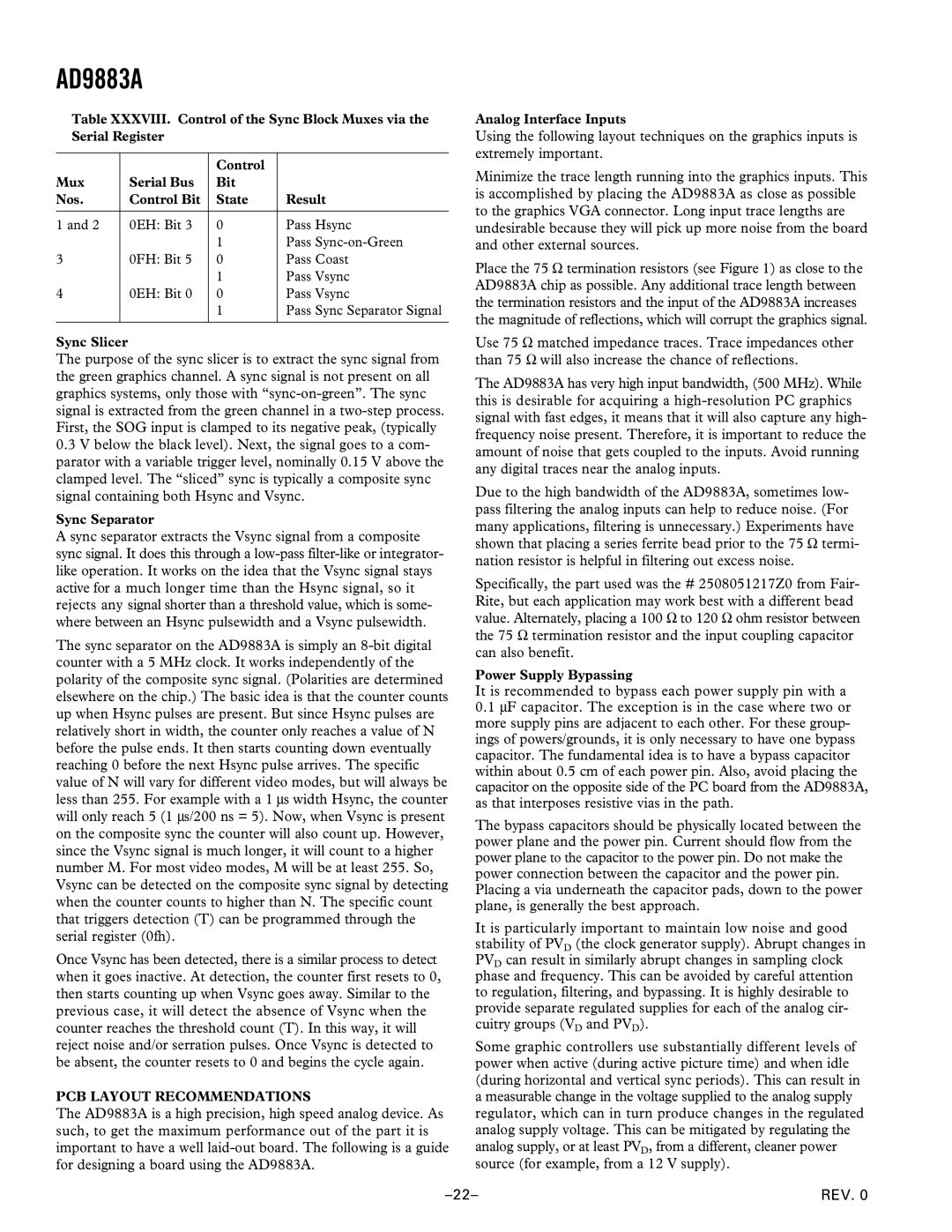AD9883A
Table XXXVIII. Control of the Sync Block Muxes via the Serial Register
|
| Control |
|
Mux | Serial Bus | Bit |
|
Nos. | Control Bit | State | Result |
|
|
|
|
1 and 2 | 0EH: Bit 3 | 0 | Pass Hsync |
|
| 1 | Pass |
3 | 0FH: Bit 5 | 0 | Pass Coast |
|
| 1 | Pass Vsync |
4 | 0EH: Bit 0 | 0 | Pass Vsync |
|
| 1 | Pass Sync Separator Signal |
|
|
|
|
Sync Slicer
The purpose of the sync slicer is to extract the sync signal from the green graphics channel. A sync signal is not present on all graphics systems, only those with
0.3V below the black level). Next, the signal goes to a com- parator with a variable trigger level, nominally 0.15 V above the clamped level. The “sliced” sync is typically a composite sync signal containing both Hsync and Vsync.
Sync Separator
A sync separator extracts the Vsync signal from a composite sync signal. It does this through a
The sync separator on the AD9883A is simply an
Once Vsync has been detected, there is a similar process to detect when it goes inactive. At detection, the counter first resets to 0, then starts counting up when Vsync goes away. Similar to the previous case, it will detect the absence of Vsync when the counter reaches the threshold count (T). In this way, it will reject noise and/or serration pulses. Once Vsync is detected to be absent, the counter resets to 0 and begins the cycle again.
PCB LAYOUT RECOMMENDATIONS
The AD9883A is a high precision, high speed analog device. As such, to get the maximum performance out of the part it is important to have a well
Analog Interface Inputs
Using the following layout techniques on the graphics inputs is extremely important.
Minimize the trace length running into the graphics inputs. This is accomplished by placing the AD9883A as close as possible to the graphics VGA connector. Long input trace lengths are undesirable because they will pick up more noise from the board and other external sources.
Place the 75 Ω termination resistors (see Figure 1) as close to the AD9883A chip as possible. Any additional trace length between the termination resistors and the input of the AD9883A increases the magnitude of reflections, which will corrupt the graphics signal.
Use 75 Ω matched impedance traces. Trace impedances other than 75 Ω will also increase the chance of reflections.
The AD9883A has very high input bandwidth, (500 MHz). While this is desirable for acquiring a
Due to the high bandwidth of the AD9883A, sometimes low- pass filtering the analog inputs can help to reduce noise. (For many applications, filtering is unnecessary.) Experiments have shown that placing a series ferrite bead prior to the 75 Ω termi- nation resistor is helpful in filtering out excess noise.
Specifically, the part used was the # 2508051217Z0 from Fair- Rite, but each application may work best with a different bead value. Alternately, placing a 100 Ω to 120 Ω ohm resistor between the 75 Ω termination resistor and the input coupling capacitor can also benefit.
Power Supply Bypassing
It is recommended to bypass each power supply pin with a
0.1∝F capacitor. The exception is in the case where two or more supply pins are adjacent to each other. For these group- ings of powers/grounds, it is only necessary to have one bypass capacitor. The fundamental idea is to have a bypass capacitor within about 0.5 cm of each power pin. Also, avoid placing the capacitor on the opposite side of the PC board from the AD9883A, as that interposes resistive vias in the path.
The bypass capacitors should be physically located between the power plane and the power pin. Current should flow from the power plane to the capacitor to the power pin. Do not make the power connection between the capacitor and the power pin. Placing a via underneath the capacitor pads, down to the power plane, is generally the best approach.
It is particularly important to maintain low noise and good stability of PVD (the clock generator supply). Abrupt changes in PVD can result in similarly abrupt changes in sampling clock phase and frequency. This can be avoided by careful attention to regulation, filtering, and bypassing. It is highly desirable to provide separate regulated supplies for each of the analog cir- cuitry groups (VD and PVD).
Some graphic controllers use substantially different levels of power when active (during active picture time) and when idle (during horizontal and vertical sync periods). This can result in a measurable change in the voltage supplied to the analog supply regulator, which can in turn produce changes in the regulated analog supply voltage. This can be mitigated by regulating the analog supply, or at least PVD, from a different, cleaner power source (for example, from a 12 V supply).
REV. 0 |
